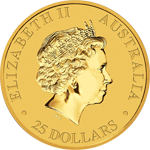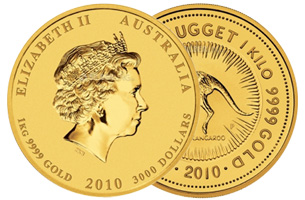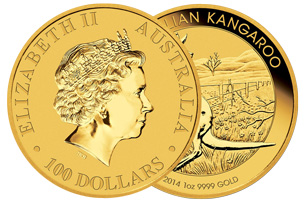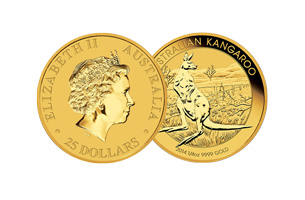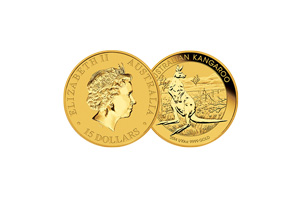The image of a kangaroo on Australia’s signature coin surprises few people. Even though many collectors and even dealer websites refer to these coins by their common name, Australian Kangaroo, the official name for these gold coins is the Australian Gold Nugget. The coin was first minted in 1986. In fact, the original designs featured images of gold nuggets on the reverse side before getting replaced with kangaroo images in 1989. This 24 karat bullion gold coin is available in the denominations of 1/20 oz, 1/10 oz, 1/4 oz, 1/2 oz, 1 oz, 2 oz, 10 oz, and 1 kg.
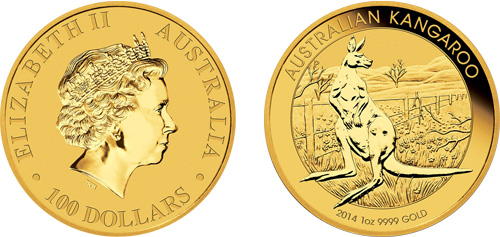
The obverse side of the coin features the profile of Queen Elizabeth II. The inscription on the obverse bears her name, the official face value for each coin, and the name of the country of Australia. Until 1989, the reverse side depicted an Australian gold nugget. However, in 1989, the design was changed to a more recognizable symbol of Australia – the kangaroo. This is why the Australian Gold Nugget is widely referred to as Australian Kangaroo. The inscription on the reverse side is THE AUSTRALIAN NUGGET. The inscription also shows the weight of the gold inside the coin, and in some cases, it may declare them to be .9999 pure.
The Gold Corporation, which operates the Perth Mint and is owned by the Western Australian Government, began minting these coins in 1986. The Perth Mint has been minting coins since 1899, and it is the oldest continuously operating mint in the country. The frosted coins each come encapsulated in plastic, and that makes them unique for government-minted coins. Furthermore, these coins are one of the very few pure gold coins that change the reverse design each year. In fact, the proof and bullion version of each year’s coins may have different images. Because of the “two-toned” frosted, variable designs, and individual plastic encapsulation of each coin, these gold bullion coins are popular collector coins that have a numismatic value that may exceed the value of the gold.
Each Australian Gold Nugget is .9999 pure.
The Australian Gold Nugget is recognized as legal tender in Australia under the Australian Currency Act of 1965. The face values of the Australian Gold Nuggets are $5, $15, $25, $50, $100, $200, $1000, and $3000. Note that in 1991, the 2-ounce coin had a face value of $500, the 10-ounce coin had a face value of $2,500, and the 1-kg coin had a face value of $10,000. In 2010, a 1/2 gram gold coin with a legal tender of $2 was introduced and up to date it is the smallest gold bullion coin ever minted.
Of course, the face value of these coins is not the same as their actual value. They have a collectable value and a gold value, which is typically much greater than the face value minted on the coin.
Besides being valuable, beautiful, and popular collectable coins, each Australian Gold Nugget is backed by the Western Australian Government. These coins also qualify as physical assets that can be invested in inside of a US Gold IRA.

